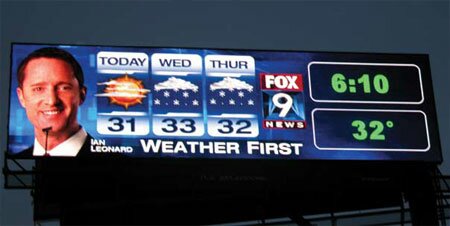
Today the King County Council is voting on whether to allow digital billboards in unincorporated areas, which would represent a huge boon to outdoor advertising giant Clear Channel. The measure, which was supposed to be voted on back in June, had to be sent back to committee when it was discovered that sufficient public notice wasn’t given.
UPDATE: It turns out the Council took the measure off the Monday agenda very late on Friday, thanks to a groundswell of public feedback. Now they’re doing further “environmental review.”
Eric Scigliano, who has been following the digital billboard story closely, mentions in passing one reason for this private-spirited advocacy:
For the record, state public-disclosure filings show that Hague and Phillips have been the biggest recipients of Clear Channel campaign donations on the County Council. Since 2003 the company has given Phillips $3,000. Hague has received $3,850 from Clear Channel, its Seattle outdoor operations president, Olivia Lippens, and Lippens’ husband.
Scigliano writes that:
…the bill had moved with unusual dispatch and unusually little notice toward passage. Officials of three cities prospectively affected by the ordinance complained that they hadn’t learned of it until the last minute, and the leading local billboard critic didn’t find out until after the council took final public comment on June 6. No citizens showed up to speak except two Clear Channel executives.
The revenue increase for Clear Channel would seem an order of magnitude, at a guess. At the moment, the billboard colossus needs to price space to take into account the trouble of pasting up or painting new artwork, where it will stay, monopolizing the space until the end of the buy (unless it’s one of those rotating billboards, which allow three different views).
With a digital billboard, it’s a new ad-pricing frontier. You could sell placements during rush hour at a premium, off-hours for less. You could display ads in virtually unlimited rotation, at different frequencies. Customers could ship in new ad content, updated as needed.
At the moment, Clear Channel is after maximum throughput: a new “static” ad every eight seconds (animation and other driver-distracting elements are theoretically not allowed, though in practice they tend to sneak in). Here’s an example of a multi-ad buy:
Scigliano quotes Clear Channel’s promise that “your ad will be seen 4,810 times per day continually 19 hours per day. Generating 134,680 advertising spots over a 4-week period.”
This creates an entirely new class of billboard customer, as people learned when they assumed graffiti artist Skull Phone had hacked his way onto billboards. No, he paid for placement. (The operating cost of the billboards is dependent largely upon the cost of electricity to light them up; here in the Northwest our hydroelectric power is gratifyingly inexpensive in comparison to other regions.)
The County Council’s Hague and Phillips profess to be swayed by the ability of the billboards to display things like Amber Alerts and other public service messages. The FBI has used digital billboards as APBs.
Dominic Holden estimates the change to unincorporated King County would affect some 21 billboards currently. (Clear Channel has 520 billboards in Seattle. It’s “Seattle” digital locations are in Kent, though, as Seattle doesn’t allow them.) Holden provides a quote from the loyal opposition, Keep King County Beautiful volunteer Paula Rees: “You can see them six miles away and they’re the most predominant feature on the landscape.”
Perhaps surprisingly, as the Tacoma News Tribune reports, the Council’s legislation turns a blind eye to the potential for light pollution:
The new ordinance, while providing some parameters on digital billboard lighting, exempts digital billboards from existing rules that forbid illuminated signs from shining direct light into homes or onto public areas.
I’m told that Clear Channel plans to stringently self-regulate.